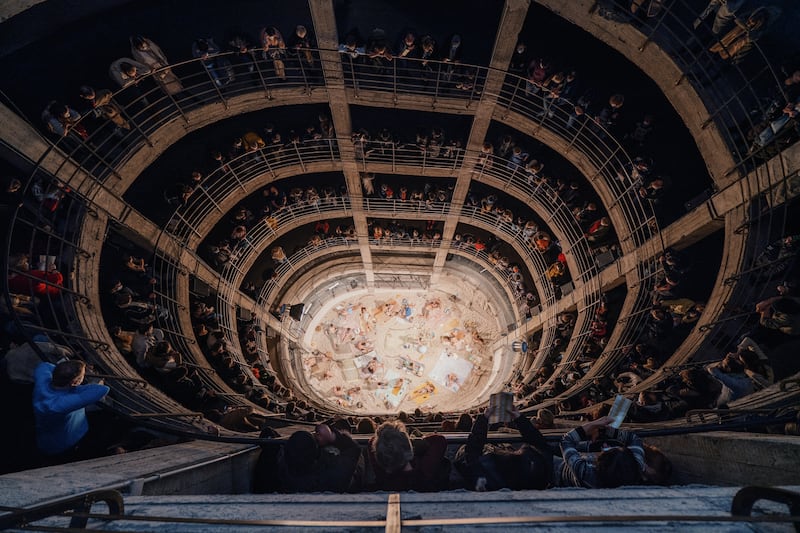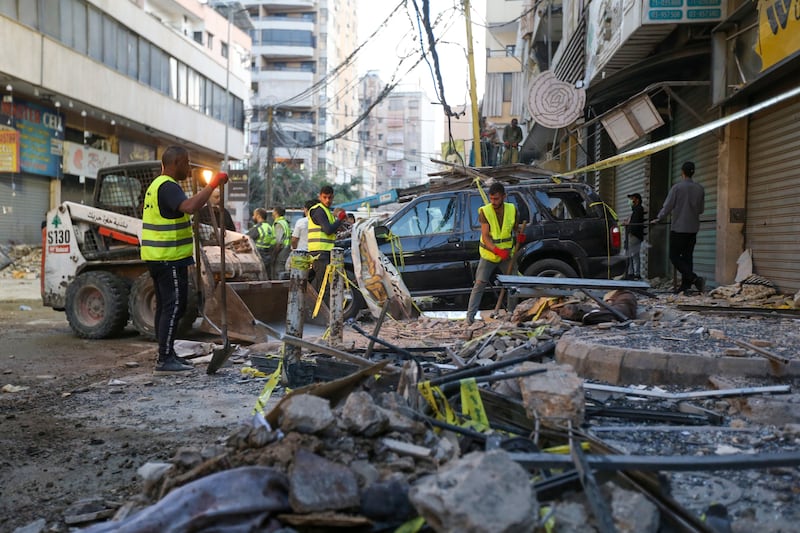It’s a scene from nearly every beach holiday you’ve been on: an expanse of sand littered with beach towels and bodies, precarious sandcastles, and buckets and spades. Under the glare of a hot sun, kids are snacking and smacking balls back and forth. Adults are sleeping under parasols as the tide recedes. There is the hum of laughter, crying, squabbling, a swathe of human emotion that together sounds a bit like music. Maybe it is music, but you can’t identify the source.
Look around you, though, and the world darkens. The revellers who stand beside you are fully clothed, leaning over an iron balcony, their faces tilted down. The beach is a theatrical mirage metres below you. The voices you think you hear murmuring intimate thoughts in song are coming from the supine figures scattered across the sand.
This is the startling situation that confronts viewers of Sun & Sea, a contemporary opera by Lina Lapelytė, Vaiva Grainytė and Rugilė Barzdžiukaitė. It arrives in Cork this month after four years of international touring that started with a Golden Lion-winning performance at the Venice Biennale in 2019, where it was presented by the Lithuanian pavilion.
Before its move to Ireland, Sun & Sea is in Vienna, as part of the city’s multidisciplinary Wiener Festwochen. Backstage, on the ground floor of the city’s Academy of Fine Arts, the show is halfway through its four-hour loop, and the ambient sound of Lapelytė’s score creates a gentle backdrop to a conversation with Barzdžiukaitė and Grainytė, the show’s director and librettist.
READ MORE

Sun & Sea was born from a previous collaboration between the artists, after they were matched by the producer Ana Ablamanova, who was keen to develop a “new type of opera”. The resulting show, Have a Good Day! – billed as an opera for 10 cashiers, supermarket sounds and piano – received rave reviews when it travelled internationally in 2013. Ablamanova “was plucking people from different disciplines to collaborate and make musical theatre”, Barzdžiukaitė says, “and this added a new energy to the more traditional opera scene we have in Lithuania”.
Buoyed by the show’s reception, the trio wanted to work together again. In 2019, as they began to discuss a new collaboration, Barzdžiukaitė shared her vision of “people being observed from above, from a bird’s-eye perspective”, and Grainytė shared a story about finding mushrooms on a forest walk in the middle of winter. From these images Sun & Sea began to grow.
Grainytė describes the development of the piece as organic and interconnected. “It’s not that I wrote the libretto and gave it to a composer to make the score,” she says. Although she was the one who started researching ideas around climate change that would go on to form the undercurrent of the show, “when I was writing the text I was sharing fragments with Rugilė and Lina, while simultaneously we were having the auditions. The people we met, their voice quality and character, inspired the narratives that we developed, so [the opera] came together bit by bit, like that, with the inspirations coming from different sides.”
An aerial view was key for Barzdžiukaitė, who had just finished making a film that was shot from above, “so there was a very direct formal link for me that inspired the piece. I had this idea that we could see all these different bodies on the beach and that would give a parallel with different cosmic bodies on Earth.” From that vantage point, she says, “we can see human beings as a species. We are always referring to bugs, for example, as this small species we can examine, so we were putting humans there and giving a distance from which we can examine behaviour, and see how fragile the human species and planet Earth are, and eventually that led us to the axis of climate change.”
We brainstormed a lot about what would be a good form for touring – whether it would be as effective as a video or a sound experience
— Rugilė Barzdžiukaitė
Barzdžiukaitė and Grainytė stress that the climate-crisis angle to Sun & Sea is incidental, rather than their main focus. “The idea for us,” Grainytė says, “was not to repeat research or make an argument. We wanted to focus on what people would be thinking or talking about while sunbathing, and to make that convincing. So the ideas are simple and mundane,” she said, in order to complement the ordinariness of the stage action. For example, the libretto contains several songs titled to emphasise everyday experience, including the Chanson of Too Much Sun (“My eyelids are heavy/ My head is dizzy/ Light and empty body/ There’s no water left in the bottle”) as well as a memorable Song of Exhaustion, sung by a workaholic unable to enjoy his holiday “because my colleagues will look down on me”. Lapelytė’s hypnotic electronic score offers moments of uncomfortable noise and ambient pleasure, adding to the shifting sense of oppression and of relaxation as the performance’s energy ebbs and flows like the invisible tide.
At the beginning of the show’s life, Barzdžiukaitė says, “maybe the message was more subtle. Maybe people would watch without prejudice and not even get to the point about climate change, because they are interested in the micro-stories of the characters.” But Sun & Sea’s profile since its success in Venice has made it difficult for audiences not to come with preconceptions. At stops in New York, Sydney, Chile and across Europe, the show has been greeted with headlines calling it a “climate crisis opera”: an opera for the apocalypse.
One of the paradoxes, Barzdžiukaitė admits, is the impact of international touring on the production’s carbon footprint. The company for Sun & Sea “consists of 26 people on an aeroplane across the world! But we try to do what we can to be efficient.” The set requires sand, which the company borrow and return at the end of a run, or repurpose: in Venice their indoor beach became a children’s playground. The company also tries to group international touring dates together, to minimise long flights.

But “we don’t pretend we are activists”, Barzdžiukaitė says. “We brainstormed a lot about what would be a good form for touring – whether it would be as effective as a video or a sound experience – and we didn’t think it would. Many people say it has made them think a lot, so our excuse is that we can reach those emotions” by touring.
Sun & Sea constantly surprises the artists even after four years. Granytė puts this down to the fact that “it is really different everywhere we go, because we are in these different architectures and they have different vibes”. In Berlin an abandoned swimming pool gave the staging a postapocalyptic vibe. In Rome a baroque theatre lent grandeur to the scene. In Vienna the site offered two balconies at different levels, which allowed audiences to move around and effectively zoom in and out as they watched.
The performers totally immerse themselves in the melodies. They become both tired and relaxed
— Vaiva Grainytė
A cast from the local community, to complement Sun & Sea’s 18 professional singers, also lends spontaneity. Dogs have pooed on the stage and people have fallen asleep, but it is the children on stage who do the most unexpected things. “They get tired, they start fighting, they throw sand – the singers are bombarded with sand in their mouths. They will WhatsApp [from the stage], saying, ‘Get the kids off for a break.’”
In fact the professional cast decided to introduce new props: water pistols, to discourage the sand fights, the grit from which makes it hard to sing. They already had enough of a challenge in singing lying down, which “goes against their physics”, as Grainytė says. “They are used to standing and having their diaphragm open.” Performing on a loop for four hours is a physical challenge too. “They totally immerse themselves in the melodies. They become both tired and relaxed.”
This is how it works for the audience as well. Watching Sun & Sea from above, you are apart from the action, but the mesmeric music immerses you in the stage world too, mimicking the effect of a never-ending day on the beach, the blurring of realities that is holiday time.
Sun & Sea runs from June 23rd to 25th as part of Cork Midsummer Festival; the festival begins on June 14th and ends on June 25th




















